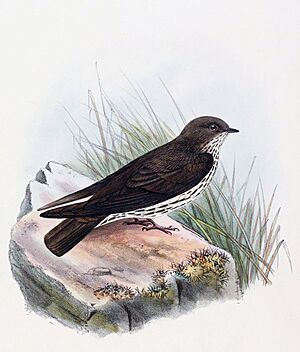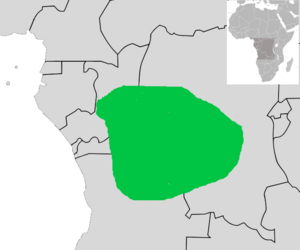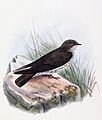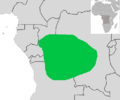Brazza's martin facts for kids
Quick facts for kids Brazza's martin |
|
|---|---|
 |
|
| Conservation status | |
| Scientific classification | |
| Genus: |
Phedinopsis
|
| Species: |
brazzae
|
 |
|
|
Approximate range in Africa
|
|
The Brazza's martin (Phedinopsis brazzae) is a small bird from the swallow family. It is about 12 centimeters (5 inches) long. This bird has grey-brown feathers on its back. Its belly is white with many black streaks. Its chest has a brownish color. Male and female Brazza's martins look similar. Young birds have lighter streaks on their chest. Their back and wing feathers have reddish-brown edges.
This bird lives in parts of Africa. You can find it in Angola, the Republic of the Congo, and the Democratic Republic of the Congo. Brazza's martins build their nests in tunnels. They dig these tunnels into river banks. They usually lay three white eggs. These birds eat flying insects, like termites. They often hunt over rivers or open grassy areas called savannas.
Brazza's martins sometimes fly with other types of swallows. You can easily spot them by their brown backs and streaked white bellies. They also have a square-shaped tail. For a long time, not much was known about this bird. But now, scientists know it is common and widespread. Since 2008, it has been listed as a species of Least Concern. This means it is not currently in danger. People might hunt these martins for food sometimes. However, this does not seem to be a big threat to the species.
Contents
About Brazza's Martin
The Brazza's martin was first described in 1886. A French scientist named Émile Oustalet gave it its first scientific name. He found a specimen in what is now the Republic of Congo. This bird is now the only species in its group, called Phedinopsis. This group name was given in 1971 by a German bird expert, Hans Edmund Wolters. The name Phedinopsis means "looks like Phedina". The species name, brazzae, honors Pierre Savorgnan de Brazza. He was a French explorer who found the first bird specimen.
Brazza's martin belongs to the swallow family. This family includes all swallows and martins. Scientists study bird DNA sequences. These studies suggest that swallows can be grouped by how they build nests. Brazza's martin builds its nest in burrows. This puts it in the "core martins" group. This group includes birds like the sand martin. Brazza's martin is thought to be an early branch from the main swallow family tree. It was once grouped with another bird called Phedina. But now it has its own group. This is because its calls and nest types are very different.
What Does Brazza's Martin Look Like?
The Brazza's martin is a small bird. It is about 12 centimeters (5 inches) long. Its wings are about 10 centimeters (4 inches) long. Its back is grey-brown. Its head is a bit darker brown. Its belly is white. It has strong blackish-brown streaks from its throat down to its bottom. The chest feathers have a brownish color. Its tail is square-shaped. It is about 4.7 centimeters (1.8 inches) long. The tail has white edges on its brown underside.
The flight feathers are blackish-brown. Its beak and legs are black. Its eyes are dark brown. The black beak is about 8.5 millimeters (0.3 inches) long. Male and female birds look alike. Young birds have lighter streaks on their chest. Their back and wing feathers have reddish-brown or yellowish-brown edges. There are no different types or subspecies of this bird.
The song of the Brazza's martin starts with short notes. These notes get faster and faster. Then comes a complex buzzing sound. Sometimes, it ends with a few soft clicks. The song gets louder as it goes on. Its flight is sometimes described as heavy. It can also be compared to the flight of a sand martin.
You can tell the Brazza's martin apart from most other swallows. Look for the heavy streaks on its belly. Another bird, the lesser striped swallow, also has white underparts with dark streaks. But it is bigger. It has a deeply forked tail. Its feathers are also very different. It has dark blue upperparts, a red bottom, and a chestnut-colored head.
Where Brazza's Martin Lives
For a long time, people did not know much about where the Brazza's martin lived. Until 1922, only one bird specimen was known. It was kept in a museum in Paris. Then, a person named Father Callewaert found 20 more martins. He found them near a place now called Kananga. Today, we know this bird breeds in the southern Democratic Republic of the Congo (DRC). It also lives in the Republic of the Congo and northern Angola. There has been one possible sighting in southeast Gabon.
During the breeding season, these martins live near rivers. They need steep river banks to dig their nest burrows. You can find good homes for them along lowland tropical rivers. The Congo River is one example. They also live near rivers with sandbanks in the highlands of Angola. The highland areas have wide grassy riverways. These run through miombo woodlands. The Congo Basin is a tropical forest. It gets a lot of rain each year.
The lowland areas have different types of woodlands. Some are dry, some flood sometimes, and some are always wet. There are also savannas that flood seasonally. The swamp forests have trees like Symphonia globulifera and raffia palms. The riverbanks often have arrowroot plants. This martin can also live in open savanna areas. It can roost there overnight when it is not breeding. This means it does not depend only on forests. It just needs its river breeding spots to survive.
How Brazza's Martin Behaves
Scientists once saw a male Brazza's martin singing to a female. The male sat about 30 centimeters (1 foot) away. It sang for about ten minutes. As it sang, the male leaned towards the female. Its wings and tail lifted up. Brazza's martins build their nests in the vertical banks of forested rivers. They do this from July to October. This is at the end of the dry season. It is before the river levels get too high and cause floods. One small group of four pairs was seen breeding near a rocky area. This was on the side of a valley.
Brazza's martins nest alone or in small groups. Their burrows can be far apart. The nest is a small pile of soft things. These can be feathers or dry grass. It is at the end of a tunnel. The tunnel is usually about 50 centimeters (20 inches) long. They normally lay three white eggs. The eggs are about 18.5 by 11.25 millimeters (0.7 by 0.4 inches). They weigh about 1.5 grams (0.05 ounces). We do not know how long it takes for the eggs to hatch. We also do not know how long it takes for the young birds to leave the nest. But like all swallows, the chicks are born naked and blind.
Like other swallows, Brazza's martins eat flying insects. This includes termites. They hunt over rivers or open savanna areas. They can be seen in groups of just their own species. Or they can be with other swallows. These include barn swallows, lesser striped swallows, or rock martins.
Conservation Status
Not many bird studies have been done in this part of Africa. So, until 2008, the Brazza's martin was listed as data deficient. This meant there was not enough information about it. People thought it lived in a much smaller area. But in 2007, a study showed new evidence. It extended the known area where they live. This area became four times larger.
The Brazza's martin has a large range. It covers about 402,000 square kilometers (155,000 square miles). We do not know the total number of birds. But its wide range and stable population mean it is listed as Least Concern. This is on the IUCN Red List. This means it is not currently facing serious threats.
It is possible that people dig up these birds for food. But their small, scattered groups in firm soil make them harder to find. They are not as easy to hunt as birds that nest in large groups in sandbanks. Breeding groups in river sandbars can be flooded. But neither natural causes nor hunting seems to be a big problem. This species does not seem to be in immediate danger. It can also live in areas that have been changed by humans. This helps it survive. The Brazza's martin is not a protected species in Angola, the DRC, or the Republic of Congo.
Images for kids





